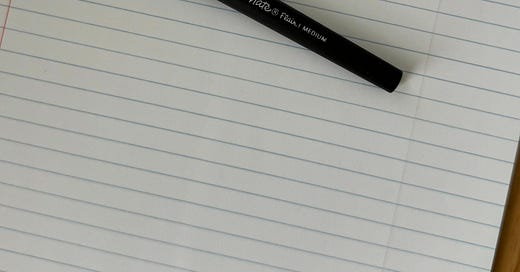When I was a young cartoonist in training, before the Internet, it was tough to find information about what professional cartoonists used to draw, draw on, how big or small to draw, and how to improve.
The thought being, that if I used the same tools, I would be just as good as my idols. But, in every interview I read or book on the subject, the specifics were rather vague. I can’t tell you how many times an artist would say, “It’s not the tools. Use what you’re comfortable with and keep practicing.” When you’re young, you just need any information to get you moving. So in the thought of paying it forward…and since every time I post a drawing, someone asks…here are my tools.
(Just be warned that they constantly change and what I use today might be gone tomorrow in favor of something else.)
WRITING
Simple. I use spiral bound college ruled notebook paper and a Paper Mate felt tip pen. I love the feel of the pen on the paper. I tend to sit in a comfy chair in my studio, drink a cup of coffee and get the mind rolling.
PENCILING
I use a Ticonderoga blue pencil and sometimes if I’m on the road, I use these Graphgear mechanical pencils. One has blue lead, the other HB. And in the case of the HB, I also have a kneaded eraser.
INKING
Here’s where it varies due to time, line quality or sometime just what I feel like.
Most of the time I use a Kuretake #13 brush pen. I use a refillable cartridge that I put Higgins Black Magic ink in.
Next is the Kuretake HIKKEI! SIGN PEN EXTRA FINE Brush Pen. It’s stiffer, but has a little line weight change depending on pressure. I think it may be discontinued because it’s out of stock everywhere.
For fine lines, I use either the Tombow Fudenosuke Fude Brush Pen Hard or the Zebra Pen Zensations Brush Pen, Brush Tip.
Then I have a Pentel brush pen that I use for filling in blacks.
All are water-resistant because I also use them for water colors.
Finally I use a Pentel Presto white-out pen and a Zig brush pen to white out stuff. The Zig can be quite frustrating when not used for a while. The brush gets dried out and the white-out globs out making a mess. Use with care.
PAPER
For straight illustration, I use Strathmore 500 series premium vellum bristol board. It’s just the best. I love the texture, the way it takes all different kind of pen and brush lines well.
For watercolors, I use Strathmore 500 series premium hot press watercolor paper. The hot press is smoother than the the cold press. I always feel like I’m inking on a topographical map with cold press. I also use Holbein artist’s watercolors from tubes. I’m still trying to improve my watercolors. I’m still stumbling in the dark. I use assorted watercolor brushes. I can’t seem to settle on one type or size.
SKETCHBOOK
I use an Illo sketchbook and I use all the tools I mentioned above.
DIGITAL
My process for drawing on a computer is pretty much the same as analog. I draw on a Cintiq Pro 24 P tablet. I use Clip Studio Paint. I will pencil with a pencil tool on a layer, ink with a brush that I made in the program on a second layer and I also color on there as well. I have a bunch of textures and paint brushes I use for that, but mostly I select a section, and fill it with a color. I’m simple. I then export a final file as a tiff and convert it to CMYK in Photoshop.
And, that’s about it. But now I find myself saying that most annoying statement I heard when I was starting out; it’s not the tools, it’s the artist. It all comes down to passion, dedication and purposeful practice. For young (or not so young) cartoonists, I hope this gives a little insight into my process and for non-artists, I hope you look at this as a peek behind the curtain where a grumpy old man pulls all the levers.















I love using those mechanical pencils. I swapped to Canson Bristol though because Blick had it on sale all the time
Thank you for sharing!